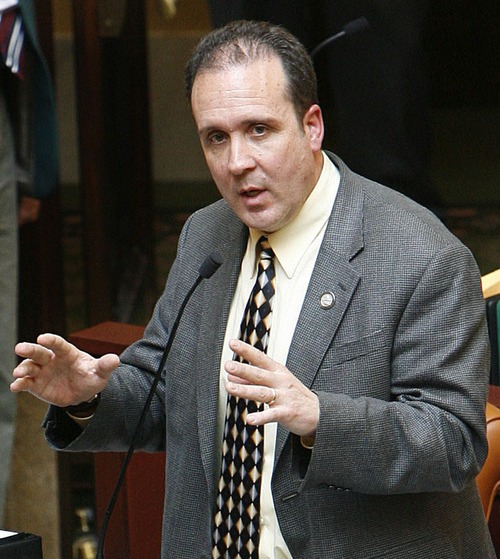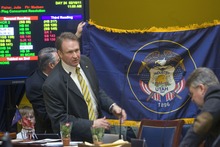This is an archived article that was published on sltrib.com in 2014, and information in the article may be outdated. It is provided only for personal research purposes and may not be reprinted.
When Utah lawmakers passed a law in 2009 empowering state prosecutors to bypass a judge to get phone and Internet records of suspects in child-pornography cases, there wasn't a single opposing vote. They had been sold on the premise that quick, urgent action was needed to save young kidnap victims and find missing kids.
Every minute matters in such cases, and proponents said that requiring prosecutors to go to court for a warrant or to federal agents for a subpoena could mean delays of hours, days or even weeks — leading to victims' injury or death.
But, in fact, speed appears to be of little consideration in most investigations initiated with these nonjudicial subpoenas.
The Salt Lake Tribune found in a review of scores of them that the average lag time between the commission of a suspected offense and issuance of an administrative subpoena was 37 days. Just 11 of the 260 subpoenas reviewed from a stack provided by the Utah attorney general's office through an open-records request were issued the same day as the suspected crime. Twenty-three had a lag time of three months or more. One was signed 343 days after a suspected crime.
None of the subpoenas provided by the attorney general listed suspected kidnapping or a missing child as the basis for the inquiry.
The vast majority were based on suspicion of possession or distribution of child porn, sexual exploitation of a minor, dealing materials harmful to a minor or enticement of a minor. Three referenced allegations of suspected molestation or abuse.
Prosecutors stand by the basic soundness of the subpoenas and the argument that they are a critical, effective tool of law enforcement. They acknowledge there's a lack of solid information about the number or types of criminal prosecutions or convictions that result from probes originating with administrative subpoenas — but say there is simply no practical way of tracking that.
That could soon change.
—
New legislation • Sen. Mark Madsen, chairman of the Senate Judiciary Committee and among the Legislature's most vocal skeptics of administrative subpoenas, is drafting legislation designed to shed light on the uses or abuses of these orders, which previously have been exposed to little scrutiny outside the agencies issuing them.
"My focus will be to dramatically improve the reporting," Madsen said in an interview. "Under the really thin requirements in the law itself, there was really no useful information for public oversight or public policy."
Indeed, the law's only requirement is that state and county prosecutors annually report the number of administrative subpoenas they issue.
Madsen's legislation, which he says will be made available for public inspection in the next few days, would require each subpoena to have a unique number that would allow tracking it all the way through the courts if it leads to a prosecution, or to the dead-end file if it does not. This mechanism, in theory, would permit collection of data on such things as the category of crime investigated, success rate of prosecution and how often emergencies — like the kidnappings described to the Legislature — were in play.
"The objective is to get real information, then take that and have meaningful discussion and policy analysis," said Madsen, an Eagle Mountain conservative who is working with the American Civil Liberties Union and other civil libertarians. "The larger issue will loom whether we want to even use these as a tool."
—
Rare cases • Craig Barlow is chief of the children's justice division in the attorney general's office. His name appeared as the authorizing prosecutor on every one of the administrative subpoenas supplied to The Tribune — about a quarter of the 1,060 issued by the office through 2012.
Asked about the apparent lack of urgency in most of these investigations, Barlow quickly acknowledged just a small fraction qualify as emergencies.
"I'm not going to try to polish a cow pie," he said, also agreeing that the type of life-and-death case highlighted in debate on Utah's Capitol Hill was rare.
"The number of true child abductions or kidnappings is small. They are cases that capture the public's attention," Barlow said. "I do know arguments were made that those more high-profile cases would be one reason getting an administrative subpoena quickly would be an advantage."
But the rarity of such cases doesn't diminish their importance, he said.
"I don't want to overdramatize the issue, but in my mind a single child at risk justifies greater urgency, even if it's only one a year."
He also pointed to reasons beyond the "exigent circumstances" argument for giving state prosecutors administrative-subpoena power. Those include the fact that evidence available at the time of the request often falls short of the "probable cause" standard required for a court-authorized search warrant and the practical consideration that precious resources are better spent working solid cases rather than going to court to get the basic name and address information usually sought in administrative subpoenas when they may or may not pan out.
Additionally, Barlow argued that using these nonjudicial subpoenas helps protect innocent people's privacy. He talked about times when some of these initial investigations may turn up information that is embarrassing — someone sharing adult porn or having sexually explicit online conversations — without any criminal activity being involved. If an investigator has gone to court to get a search warrant, that information becomes public, but it remains private under the administrative subpoena.
"We're not interested in spilling dirty laundry that's not illegal but can be embarrassing," Barlow said.
That is different than the narrative heard in legislative debates leading up to adoption of the law.
—
Making law • Prosecutors, investigators and legislative sponsors of the administrative-subpoena power focused almost entirely on child kidnappings and missing children in pressing their case in the Legislature. These were instances when time-consuming requirements to go to court or to seek the sign-off of federal agents could result in the preventable death or abuse of young victims.
Then-Rep. Brad Daw, R-Orem, sponsored the original bill in 2009.
"The scenario under which this power would be used is in the case when we have a child that's been abducted and it's clearly a stranger abduction," Daw said on the House floor. "As you can well imagine, this is a situation that is very time sensitive and every minute counts and allowing the attorneys general to simply issue the subpoena themselves oftentimes can save hours if not days of time, which may make the difference — well, let's just say it could avert tragedy if we can have that authority with the A.G.'s office."
The measure passed without a dissenting vote in either chamber, was signed by then-Gov. Jon Huntsman and took immediate effect.
It was a different story when Daw returned a year later with a sweeping proposal to expand the noncourt subpoena power to any suspected felony. Several lawmakers attacked it as a dramatic expansion of the executive branch's unilateral power to root around in information considered private by most people.
The bill failed, but it was quickly revived after being whittled back to cover a specific list of crimes — the Internet sex crimes against children already in the year-old law, plus child kidnapping and stalking.
While some still questioned the need for expanding the subpoena power and, indeed, the validity of the 2009 law, supporters pushed back. Once again, child kidnapping and missing children were used as Exhibit A.
—
The data • The Tribune's analysis of the 260 administrative subpoenas provided by the attorney general's office shows that fewer than 2 percent were based on evidence of abuse. Not a single one contained allegations of kidnapping or a missing child.
Madsen says the newspaper's findings affirm his suspicions, but he stopped short of calling the legislative presentations misleading.
"From their perspective, I think they just tried to use their best argument. But they used it over and over again," Madsen said. They "ginned up emotions" to the point, "I do think probably that many of my colleagues may have focused on what the promoters and sponsors wanted them to focus on. ... It was kind of a bum's rush." —
Administrative subpoenas
1,060 • Number issued by Utah attorney general's office from 2009 through 2012
260 • Number of subpoenas made available in response to a Tribune open-records request
37 • Average number of days between time of suspected crime and issuance of subpoena
11 • Subpoenas issued the same day as the suspected offense
343 • Longest number of days between time of suspected offense and issuance of subpoena
Three • Subpoenas that referenced suspected abuse
0 • Subpoenas that referenced a child kidnapping or missing child
77 • Number of subpoenas to Comcast
68 • Subpoenas to Qwest
115 • Subpoenas issued to all other ISPs or telephone companies
Source: Subpoenas provided by attorney general's office







